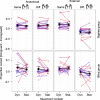Task demands affect spatial reference frame weighting during tactile localization in sighted and congenitally blind adults
- PMID: 29228023
- PMCID: PMC5724835
- DOI: 10.1371/journal.pone.0189067
Task demands affect spatial reference frame weighting during tactile localization in sighted and congenitally blind adults
Abstract
Task demands modulate tactile localization in sighted humans, presumably through weight adjustments in the spatial integration of anatomical, skin-based, and external, posture-based information. In contrast, previous studies have suggested that congenitally blind humans, by default, refrain from automatic spatial integration and localize touch using only skin-based information. Here, sighted and congenitally blind participants localized tactile targets on the palm or back of one hand, while ignoring simultaneous tactile distractors at congruent or incongruent locations on the other hand. We probed the interplay of anatomical and external location codes for spatial congruency effects by varying hand posture: the palms either both faced down, or one faced down and one up. In the latter posture, externally congruent target and distractor locations were anatomically incongruent and vice versa. Target locations had to be reported either anatomically ("palm" or "back" of the hand), or externally ("up" or "down" in space). Under anatomical instructions, performance was more accurate for anatomically congruent than incongruent target-distractor pairs. In contrast, under external instructions, performance was more accurate for externally congruent than incongruent pairs. These modulations were evident in sighted and blind individuals. Notably, distractor effects were overall far smaller in blind than in sighted participants, despite comparable target-distractor identification performance. Thus, the absence of developmental vision seems to be associated with an increased ability to focus tactile attention towards a non-spatially defined target. Nevertheless, that blind individuals exhibited effects of hand posture and task instructions in their congruency effects suggests that, like the sighted, they automatically integrate anatomical and external information during tactile localization. Moreover, spatial integration in tactile processing is, thus, flexibly adapted by top-down information-here, task instruction-even in the absence of developmental vision.
Conflict of interest statement
Figures



Similar articles
-
Spatial coordinate systems for tactile spatial attention depend on developmental vision: evidence from event-related potentials in sighted and congenitally blind adult humans.Eur J Neurosci. 2008 Aug;28(3):475-83. doi: 10.1111/j.1460-9568.2008.06352.x. Eur J Neurosci. 2008. PMID: 18702719
-
Movement Induces the Use of External Spatial Coordinates for Tactile Localization in Congenitally Blind Humans.Multisens Res. 2015;28(1-2):173-94. doi: 10.1163/22134808-00002485. Multisens Res. 2015. PMID: 26152057
-
Partial recovery of visual-spatial remapping of touch after restoring vision in a congenitally blind man.Neuropsychologia. 2013 May;51(6):1119-23. doi: 10.1016/j.neuropsychologia.2013.03.004. Epub 2013 Mar 13. Neuropsychologia. 2013. PMID: 23499851
-
Plasticity of multisensory dorsal stream functions: evidence from congenitally blind and sighted adults.Restor Neurol Neurosci. 2010;28(2):193-205. doi: 10.3233/RNN-2010-0500. Restor Neurol Neurosci. 2010. PMID: 20404408 Review.
-
Vision affects tactile target and distractor processing even when space is task-irrelevant.Front Psychol. 2014 Feb 6;5:84. doi: 10.3389/fpsyg.2014.00084. eCollection 2014. Front Psychol. 2014. PMID: 24567727 Free PMC article. Review.
Cited by
-
Effects of attentional focus on spatial localization of distal body parts and touch in two-arm position matching.Exp Brain Res. 2024 Dec 19;243(1):27. doi: 10.1007/s00221-024-06976-8. Exp Brain Res. 2024. PMID: 39699636
-
Alpha-band oscillations reflect external spatial coding for tactile stimuli in sighted, but not in congenitally blind humans.Sci Rep. 2019 Jun 25;9(1):9215. doi: 10.1038/s41598-019-45634-w. Sci Rep. 2019. PMID: 31239467 Free PMC article.
-
External location of touch is constructed post-hoc based on limb choice.Elife. 2020 Sep 18;9:e57804. doi: 10.7554/eLife.57804. Elife. 2020. PMID: 32945257 Free PMC article.
-
Chinese Children with Congenital and Acquired Blindness Represent Concrete Concepts in Vertical Space through Tactile Perception.Int J Environ Res Public Health. 2022 Sep 3;19(17):11055. doi: 10.3390/ijerph191711055. Int J Environ Res Public Health. 2022. PMID: 36078767 Free PMC article.
-
Modality-specific attention attenuates visual-tactile integration and recalibration effects by reducing prior expectations of a common source for vision and touch.Cognition. 2020 Apr;197:104170. doi: 10.1016/j.cognition.2019.104170. Epub 2020 Feb 6. Cognition. 2020. PMID: 32036027 Free PMC article.
References
-
- Alais D, Burr D. The Ventriloquist Effect Results from Near-Optimal Bimodal Integration. Curr Biol. 2004;14: 257–262. doi: 10.1016/j.cub.2004.01.029 - DOI - PubMed
-
- Angelaki DE, Gu Y, DeAngelis GC. Multisensory integration: psychophysics, neurophysiology, and computation. Curr Opin Neurobiol. 2009;19: 452–458. doi: 10.1016/j.conb.2009.06.008 - DOI - PMC - PubMed
-
- Ernst MO, Banks MS. Humans integrate visual and haptic information in a statistically optimal fashion. Nature. 2002;415: 429–433. doi: 10.1038/415429a - DOI - PubMed
-
- Pouget A, Deneve S, Duhamel J-R. A computational perspective on the neural basis of multisensory spatial representations. Nat Rev Neurosci. 2002;3: 741–747. doi: 10.1038/nrn914 - DOI - PubMed
-
- Sober SJ, Sabes PN. Flexible strategies for sensory integration during motor planning. Nat Neurosci. 2005;8: 490–497. doi: 10.1038/nn1427 - DOI - PMC - PubMed
MeSH terms
LinkOut - more resources
Full Text Sources
Other Literature Sources

